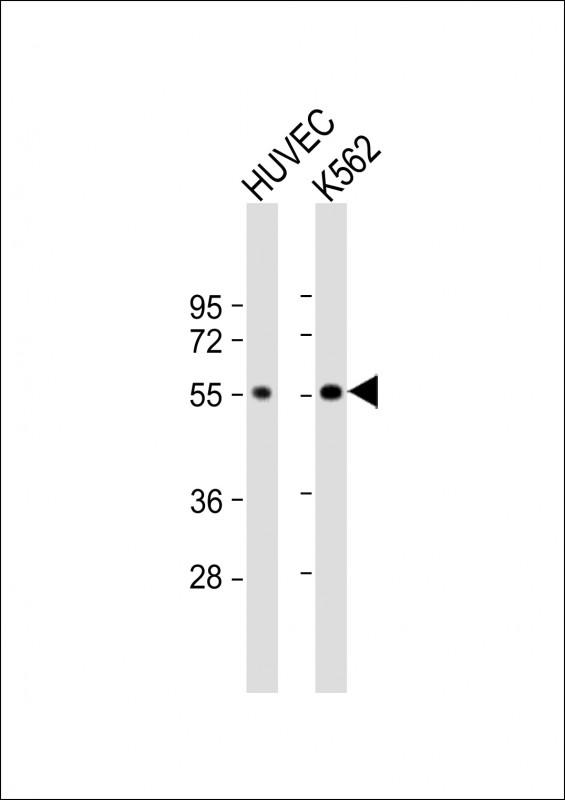AVPR1B Antibody (C-term)
Affinity Purified Rabbit Polyclonal Antibody (Pab)
- 产品详情
- 实验流程
- 背景知识
Application
| WB, E |
|---|---|
| Primary Accession | P47901 |
| Other Accession | NP_000698.1 |
| Reactivity | Human |
| Host | Rabbit |
| Clonality | Polyclonal |
| Isotype | Rabbit IgG |
| Calculated MW | 46971 Da |
| Antigen Region | 289-317 aa |
| Gene ID | 553 |
|---|---|
| Other Names | Vasopressin V1b receptor, V1bR, AVPR V1b, AVPR V3, Antidiuretic hormone receptor 1b, Vasopressin V3 receptor, AVPR1B, AVPR3, VPR3 |
| Target/Specificity | This AVPR1B antibody is generated from rabbits immunized with a KLH conjugated synthetic peptide between 289-317 amino acids from the C-terminal region of human AVPR1B. |
| Dilution | WB~~1:1000 E~~Use at an assay dependent concentration. |
| Format | Purified polyclonal antibody supplied in PBS with 0.09% (W/V) sodium azide. This antibody is purified through a protein A column, followed by peptide affinity purification. |
| Storage | Maintain refrigerated at 2-8°C for up to 2 weeks. For long term storage store at -20°C in small aliquots to prevent freeze-thaw cycles. |
| Precautions | AVPR1B Antibody (C-term) is for research use only and not for use in diagnostic or therapeutic procedures. |
| Name | AVPR1B (HGNC:896) |
|---|---|
| Synonyms | AVPR3, VPR3 |
| Function | Receptor for arginine vasopressin. The activity of this receptor is mediated by G proteins which activate a phosphatidyl- inositol-calcium second messenger system. |
| Cellular Location | Cell membrane; Multi-pass membrane protein |
For Research Use Only. Not For Use In Diagnostic Procedures.
Provided below are standard protocols that you may find useful for product applications.
BACKGROUND
The protein encoded by this gene acts as receptor for arginine vasopressin. This receptor belongs to the subfamily of G-protein coupled receptors which includes AVPR1A, V2R and OXT receptors. Its activity is mediated by G proteins which stimulate a phosphatidylinositol-calcium second messenger system. The receptor is primarily located in the anterior pituitary, where it stimulates ACTH release. It is expressed at high levels in ACTH-secreting pituitary adenomas as well as in bronchial carcinoids responsible for the ectopic ACTH syndrome. A spliced antisense transcript of this gene has been reported but its function is not known.
REFERENCES
van West, D., et al. Psychiatry Res 179(1):64-68(2010)
Binder, E.B., et al. Arch. Gen. Psychiatry 67(4):369-379(2010)
Bosker, F.J., et al. Mol. Psychiatry (2010) In press :
van West, D., et al. Psychiatr. Genet. 19(2):102-103(2009)
Tabakoff, B., et al. BMC Biol. 7, 70 (2009) :
终于等到您。ABCEPTA(百远生物)抗体产品。
点击下方“我要评价 ”按钮提交您的反馈信息,您的反馈和评价是我们最宝贵的财富之一,
我们将在1-3个工作日内处理您的反馈信息。
如有疑问,联系:0512-88856768 tech-china@abcepta.com.























 癌症的基本特征包括细胞增殖、血管生成、迁移、凋亡逃避机制和细胞永生等。找到癌症发生过程中这些通路的关键标记物和对应的抗体用于检测至关重要。
癌症的基本特征包括细胞增殖、血管生成、迁移、凋亡逃避机制和细胞永生等。找到癌症发生过程中这些通路的关键标记物和对应的抗体用于检测至关重要。 为您推荐一个泛素化位点预测神器——泛素化分析工具,可以为您的蛋白的泛素化位点作出预测和评分。
为您推荐一个泛素化位点预测神器——泛素化分析工具,可以为您的蛋白的泛素化位点作出预测和评分。 细胞自噬受体图形绘图工具为你的蛋白的细胞受体结合位点作出预测和评分,识别结合到自噬通路中的蛋白是非常重要的,便于让我们理解自噬在正常生理、病理过程中的作用,如发育、细胞分化、神经退化性疾病、压力条件下、感染和癌症。
细胞自噬受体图形绘图工具为你的蛋白的细胞受体结合位点作出预测和评分,识别结合到自噬通路中的蛋白是非常重要的,便于让我们理解自噬在正常生理、病理过程中的作用,如发育、细胞分化、神经退化性疾病、压力条件下、感染和癌症。






